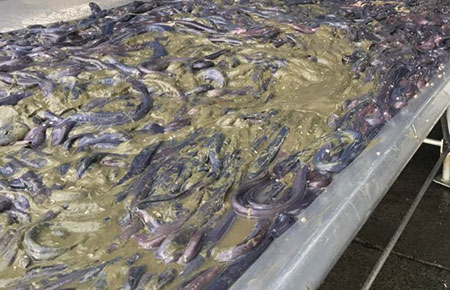Hagfish
(Eptatretus deani)
Species Profile
Did You Know?
One half-pound hagfish can fill a five-gallon bucket with slime in a matter of seconds.
General Description
Hagfish are bottom-dwelling, eel-shaped marine creatures. Pacific and black hagfish are found in the waters off the coasts of the north Pacific; black hagfish are more common than the Pacific hagfish in the Inside Waters of southern Southeast Alaska.
They are sexually dimorphic — a mature female hagfish is typically 63 cm long (25 inches) and males are typically 48 cm (19 inches); females are heavier as well, 260 grams (nine ounces) and males are 180 grams (6 ounces).
Hagfish are blind, but they do have eye spots. 300-million-year-old fossils of hagfish show an almost identical animal, but with what appears to be functioning eyes.
They're agnathans — jawless fishes, and they are the only vertebrate with a skull but no vertebrae. Hagfish and the distantly related lampreys diverged from early vertebrates prior to the evolution of dentine, which enables vertebrate animals to have teeth. They have mouth parts that function like teeth but these parts are re-absorbed and re-grown, which means they can't be used to age hagfish. At this point, biologists haven't identified a means to age individual animals.
There are 76 species of hagfish. Conventional thought has been that they are scavengers, but recent studies on Atlantic hagfish show they eat crustaceans and worms, and scavenging is opportunistic.
Hagfish are known for their ability to produce slime, a clear, thick gel that looks like egg white but is substantial and cohesive. It's viscous enough that you can hold it. You can pick it up in a glob, stretch it out in a sheet and drop it, and nothing will be on your skin. Left to dry, it's like a slug slime trail, dry and shiny, and it breaks apart.
The fish don't produce slime; they have special glands that excrete "pre-slime," protein molecules that react with water to tremendously expand in volume. Hagfish gland thread cells produce fibers, "threads" that unravel when they are ejected into seawater. Gland mucus cells simultaneously produce mucus, and they function together to form the slime in just a fraction of a second.
The slime serves the fish in a variety of ways. In its natural environment, the excretion reacts with water immediately, encasing the animal in a ball of slime. In the face of a predator, this is distracting and impairs the function of a fish's gills. When the need for slime has passed, the hagfish ties itself into a simple overhand knot and works the knot from head to tail, scraping off the slime ball so the hagfish can swim away unencumbered.
It's mainly defensive, but they also produce slime when they feed. Research has also found that hagfish are able to squeeze through openings that are less than half the width of their bodies. This ability helps them move, burrow, scavenge, and avoid predators.
Life History
Very little is known about hagfish mating. Reproduction and spawning have never been witnessed or documented, and they've never successfully reproduced or spawned in captivity. Biologists don't know where they spawn, or when they spawn. It's not known how long hagfish live.
Of the 76 species of hagfish, some are hermaphroditic. Juvenile Pacific hagfish are sexually undifferentiated. At some point is seems they are protandric - they are male and then switch to female.
In a 2017 test fishery, the catch rate of black hagfish was 90 percent female. Researchers are working to learn if that is the optimal sex ratio for the species, or if fishing somehow targets females more than males.
Biologists looking at female hagfish have established five stages of egg development for their sampling protocol, the fifth stage being a spawned out female hagfish. In the early stages, eggs are the size of rice grains, when they are nearly developed, stage three, they are like white beans about an inch or more long, and can be seen through the animal's skin. When ready to be deposited the eggs develop a gelatinous cap on each end containing hooks that allow the eggs to attach end-to-end in a long string. A mature female will have 20 to 40 eggs.
Range and Habitat
Pacific and black hagfish are found in the waters off the coasts of the north Pacific; in Alaska black hagfish are more common than Pacific hagfish in the Inside Waters of southern Southeast Alaska. Their ranges overlap, but the species are typically separated by depth where Pacific hagfish tend to be shallower (10-100 fathoms) and black hagfish are found deeper (200-300 fathoms).
In a 2017 test fishery in Southern Southeast Alaska, (in Clarence Strait and Behm Canal), the catch was 99 percent black hagfish and one percent Pacific hagfish - the opposite catch ratio that occurs off the Oregon, Washington and California coasts. Black hagfish are caught at depths 200 fathoms or greater, and the hagfish prefer muddy bottoms where they can burrow.
Status, Trends, and Threats
The status of hagfish is largely unknown. Researchers in Alaska are proceeding cautiously with the development of a potential fishery to insure harvest is sustainable. Because their fecundity is low, it's easy to collapse the fishery. Korea's fishery collapsed in the 1940s.

